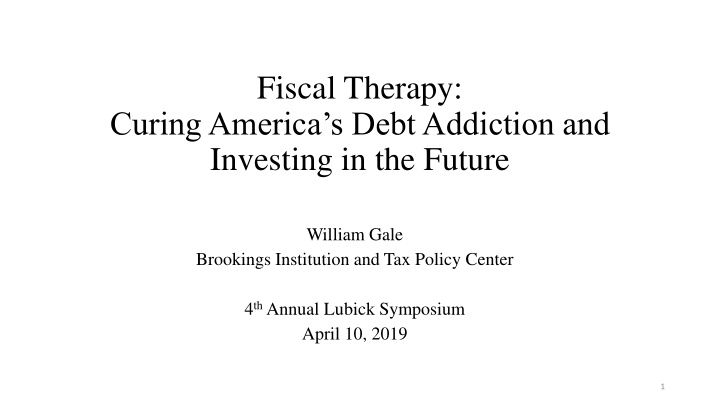



Fiscal Therapy: Curing America’s Debt Addiction and Investing in the Future William Gale Brookings Institution and Tax Policy Center 4 th Annual Lubick Symposium April 10, 2019 1
The Bottom Line • America faces two intertwined problems • Rising debt • Lagging investment • Three-part solution • Control entitlements (preserve anti-poverty and social insurance features) • Boost children’s programs, human capital, infrastructure, and research • Raise and reform taxes 2
Debt/GDP, 1790-2018 106% 78% 3
This Time is Different 4
A Fiscal Policy Rorschach Test 5
The Changing Composition of Spending 8.5% 6.7% 6.1% 2.6% 2.1% 2.1% 6
Effects of Debt on the Economy • Not all debt is bad • Not a crisis • But our long-term debt situation is still a problem • Economic • Political / Fiscal space 7
A Debt Target • 60% of GDP by 2050 • Average over the business cycle • Not zero debt / not a balanced budget rule • Higher than historical average (36% between 1957-2007) • Interest rates likely to be lower than in the past • More investment => higher sustainable debt • Baseline debt level is so high • But not higher because it is not clear how much better off future generations will be 8
Will Future Generations be Better Off than We Are? Source: Chetty, et al. (2016) 9
Fiscal Gap = 4.0% of GDP (To reach Debt/GDP = 60% by 2050, starting in 2021) 10
False Solutions • “Foreign aid” • Inflation • Growth – could help, but not enough • Tax Cuts 11
Healthcare and Social Security • Healthcare • Expand coverage – reinstate the mandate (or equivalent), provide public option, expand Medicaid • Control costs – premium support in Medicare, provider payment reform, let Medicare negotiate drug prices and formulary • Social Security (BPC Plan) • Raise retirement age and index benefits with chained CPI • Make annual benefits more progressive • Raise payroll tax rates and the payroll tax cap 12
Invest in the Future • Extra 1% of GDP to strengthen social policy • Invest in children, child care, and education • Patch current holes and raise take-up rates • Provide job training and (if required for eligibility) jobs • Make work pay better • Infrastructure/R&D • Invest an added 0.5% of GDP in infrastructure (to meet ASCE goals) • Double federal R&D relative to today’s share of GDP 13
Raise and Reform Taxes • Carbon tax – $30 per ton rising at 5% above inflation (McKibbin, et. al), with offsets • Value-added tax – 10% rate, with offsets • Business taxes • Repeal TCJA pass-through provisions (or let them expire) • Raise corporate tax to a 25%, convert to “cash flow” tax • Revisit international rules • Personal taxes • Close capital gains loopholes, raise capital gains rates • Repeal TCJA rate cuts and bracket changes (or let them expire) • Replace MID with a first- time homebuyers’ tax credit • Estate tax reform/inheritance tax • Increase IRS funding and enforcement 14
Fiscal Outcomes under the Baseline 15
Fiscal Outcomes under the Proposal 16
Fiscal Outcomes under the Proposal 17
Fiscal Outcomes under the Proposal 18
Fiscal Outcomes under the Proposal 19
Debt/GDP under the Proposal 20
Effects • Raise Growth • Reduced debt • Corporate tax changes • Increased infrastructure and R&D • Increased investment in children, safety net, jobs/education • Reduce inequality and increase mobility • Progressive tax changes • Increased investment in children, safety net, jobs/education • Honest/transparent plan • Specified changes • Realistic and administrable reforms • No growth effects included in budget estimates 21
Tax Levels and Growth, US vs G7, 1970-2015
Interest payments, 1950-2050 23
Politics • Debt reduction is a classic “Olson” problem • Concentrated costs, diffuse benefits • Schultze: Hippocratic Oath for politicians • Public opinion is conflicted • No New Taxes pledge complicates any discussion • Structure of government makes major change difficult • Partisanship, polarization, tribalism … no trust • No crisis • No leadership 24
Cause for Hope? • Fiscal sustainability is consistent with both conservative and liberal goals • There is much to be gained from fiscal reform • Two alternative paths: • “Get rid of the deductions that don’t affect me.” • “You can always count on Americans to do the right thing … after they have exhausted all of the other options.” 25
Recommend
More recommend